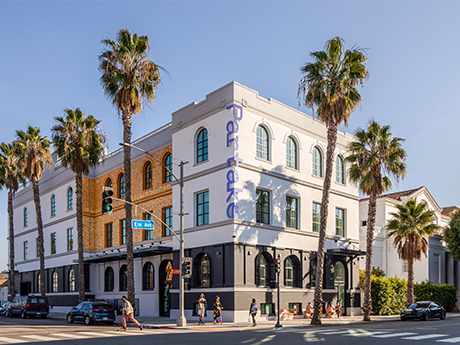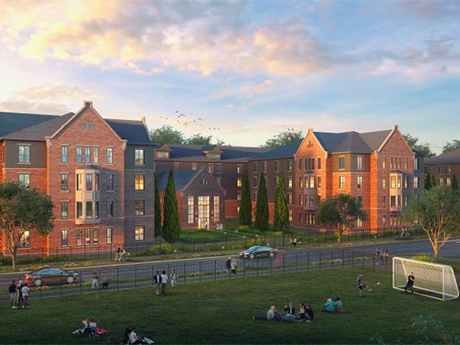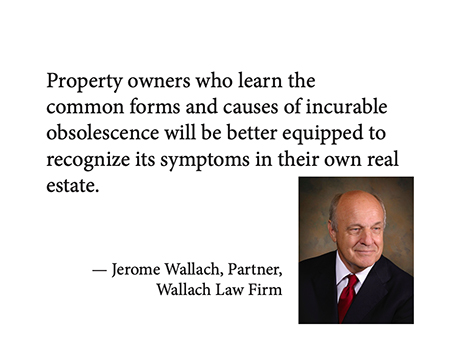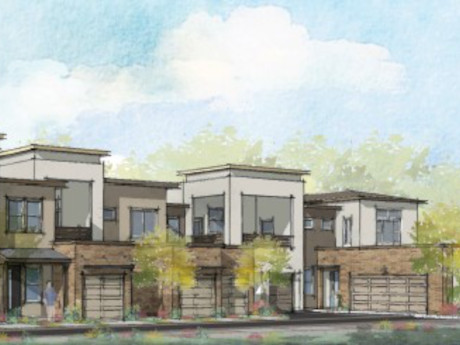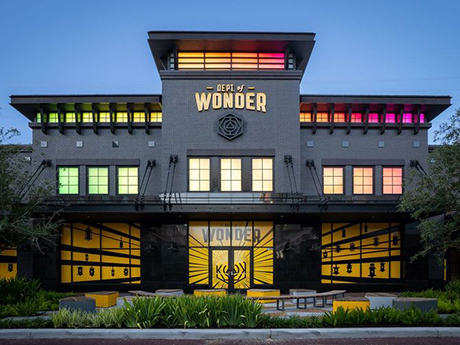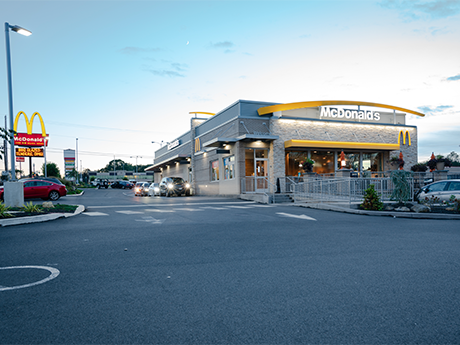— By Elise Kunihiro and Maura Schafer — Historic building adaptive reuse creates a bridge between the past and the future, resulting in places that can become the hearts and souls of their communities. The reuse of these buildings offers community benefits, such as sustainability, new public spaces and character. Reactivate local economies Beyond revitalizing older buildings, adaptive reuse projects can also support small local business owners. A 1922 brick office building in the East Village Arts District of downtown Long Beach, Calif., for example, now hosts Partake Collective. The 25,000-square-foot cloud concept and food hall incubator allows visitors to support local restauranteurs while dining in a communal food hall or sidewalk dining area. Studio One Eleven served as the project’s architect, while RDC did interiors and procurement. The goal of this redevelopment model was to create a benchmark for future development that celebrates food diversity and enhances community building. It doesn’t hurt that Partake Collective remains an active and engaged member of the Long Beach community by working with local educational institutions to support pathways to private enterprise, business ownership and job opportunities for the most underrepresented communities. Partake Collective has already partnered with culinary programs at Browning High …
Features
Economic Environment, High Tenant Demand Spur Increase in Public-Private Student Housing Projects
by Katie Sloan
In a way, the dynamics of public-private partnerships (P3s) are the same as they’ve always been. “The reasons why universities elect to go the P3 route haven’t changed much,” says Michael Baird, managing director of municipal finance for RBC Capital Markets. “For many, the decision is made based on speed to market. This happens when other alternatives can take years — resulting in an opportunity cost of not being able to provide housing to students that need housing now, in addition to increased development expenses as construction costs continue to increase year over year.” These costs — both the ones saved and the ones incurred by the university — have become increasingly important in today’s economic climate. The cost of construction materials has increased by an average of 19 percent since 2020, notes facility and construction insights provider Gordian. Meanwhile, the annual student housing rent at purpose-built communities rose by an average of 8.8 percent between November 2022 and May 2023, according to RealPage. Construction costs make it easy to see why it’s more difficult to get projects to pencil right now…and increasing demand shows why it’s more important than ever to get them off the ground. Jay Pearlman, senior vice president …
Incurable obsolescence — the stealth killer of commercial real estate value — is all too often overlooked in property tax appeals. Any obsolescence can affect a property’s value. Normal obsolescence involves curable problems, such as outdated fixtures and finishes that reduce a building’s desirability. In valuation, the anticipated cost to cure the obsolescence (in this case, with a refreshed interior) is deducted from the property’s taxable value. As the name suggests, incurable obsolescence cannot be cured within the boundaries of the property. The obsolescence stems from outside circumstances, whether next door or in the larger markets, and no change to the property itself can overcome the deficiency. Perhaps the government is going to change the traffic pattern, or a hog farm is going in next door. The market value may rise if a good thing is coming to the area. It will surely decline if a bad thing is coming, and the market value declines in relation to the predictability of such an event. Property owners who learn the common forms and causes of incurable obsolescence will be better equipped to recognize its symptoms in their own real estate. In arguing for a reduced tax assessment value, evidence of obsolescence …
EEE Panelists: Today’s Premier Entertainment Experiences Merge the Physical, Digital Worlds
by Jeff Shaw
LOS ANGELES — Brick-and-mortar spaces aren’t the only areas where consumers exist nowadays. There’s the omnichannel approach that includes online shopping, yes, but today’s forward-thinking landlords and tenants know that the digital sphere is the next great conquest. This was one of the primary arguments made at InterFace Conference Group’s Entertainment Evolution Experience (EEE), which was held at the J.W. Marriott at L.A. Live in downtown Los Angeles this week. “Consumers are back and looking for experiences, but it really has to mean something to leave the sofa and comfort of Netflix and go into a shopping center,” said Benjamin Calleja, founder and chief experience officer for Livit Design, as well as the conference keynote speaker. “Digital is blurring the lines between the physical and virtual worlds, creating more ways to transform spaces.” One only needs to look as far as the latest entertainment concepts to see how digital assets are playing an integral role in today’s shopping centers. Concepts like Dreamflyer, a virtual reality (VR) flight simulator, and the immersive Elvis Evolution that includes a “concert” from the late Elvis Presley illustrate how digital displays can merge with sensory experiences to create a new entertainment opportunity. Travis Cloyd, CEO …
By Adam Wolfson and Darryl Kasper of Wolfson Development Co. Against a backdrop of recently proposed (though unlikely to pass) legislation aimed at forcing large build-to-rent (BTR) and single-family-rental investors to shed units and convert them to for-sale housing, BTR fundamentals — and the investment case for the sector — remain strong as ever. While debatably well-intentioned, the legislation mistakes correlation for causation. The BTR sector is indeed benefitting from problems in the housing market. However, these problems pre-dated the industry and are more likely caused by factors such as inflation, high interest rates and limited supply. These forces are at play throughout the United States, but they are especially prevalent in the Southeast, where they align to create what could be the perfect storm for BTR rent growth. Inflation, Wage Growth Will Drive Rent Growth Inflation has run rampant since mid-2021 for a variety of reasons, including economic dislocation caused by the pandemic and the subsequent stimulus packages the U.S. government provided in response, as well as high gasoline prices and a supply chain crisis. According to U.S. Inflation Calculator, the annual inflation rate skyrocketed from 1.4 percent in 2020 to 7 percent in 2021, then fell slightly to …
The economy has constricted consumers’ wallets, but the desire for entertainment has kept them spending…on the right concepts. Rising prices have made just about everyone conscientious about their spending. That, naturally, includes shoppers. Dixon Greenwood, principal at Mountain Mile in Pigeon Forge, Tennessee, notes 2023 overall tax receipts at the dining, shopping, lodging and entertainment destination are down more than 10 percent from the company’s 2022 numbers. “Now, that’s off some extreme growth during and after COVID, so numbers are still very good, but what it says pretty clearly is people are tightening their purse strings,” he says. Traffic, on the other hand, is only down 2 percent to 3 percent. “Fortunately for us, we’re still trending up at our property, but that’s in part because we continued to add additional retailers and experiences last year,” Greenwood continues. A large part of what’s compelling visitors into shopping centers nowadays is entertainment, especially if prices for goods are lower online. “There has been somewhat of a drop in consumer spending, but entertainment remains a ‘recession-proof’ outlet,” argues David Goldfarb, owner, CEO and founder of entertainment-solutions company PrimeTime Amusements. Goldfarb is careful to note, however, that recession-proof doesn’t mean bulletproof. After all, …
AcquisitionsContent PartnerDevelopmentFeaturesIndustrialLee & AssociatesLoansMidwestMultifamilyNortheastOfficeRetailSoutheastTexasWestern
Property Owners Recalibrate Expectations Following Financing Challenge, Shifting Vacancy Rates
High costs, modulating occupancies and a lack of financing options reshaped the industrial, office, retail and multifamily sectors in the fourth quarter of 2023, signaling the determining factors for 2024, according to Lee & Associates’ 2023 Q4 North America Market Report. The industrial sector saw stabilizing tenant demand — the number of new buildings delivered increased in the fourth quarter, while new construction starts slowed. Meanwhile, the office sector’s struggles deepened as more than half of the office leases signed pre-2020 approach their expiration by 2026. With low-rate loans maturing into a high-rate environment, the factors troubling the office sector seem insurmountable in this decade. In the retail market, low vacancies did not lead to booming construction in that sector in the last quarter of 2023 — financing costs plus land and labor costs have hampered new development in spite of high demand. Finally, the health of multifamily markets is tied closely to geography. Sun Belt multifamily properties and their Midwest and Northeastern market counterparts are seeing reversals from the multifamily trends of 2021: formerly fast-growing Sun Belt markets are experiencing slowed rent growth or rent decline, while rent growth for slower-growing, major North and Midwestern metros has grown steadily. Lee & Associates …
By Charvi Gupta of Getzler Henrich & Associates LLC Vacancy rates in office buildings in major metropolitan areas like New York City have surged, driven by the widespread adoption of remote work policies as well as the relocation of major corporate headquarters. With housing shortages exacerbating the issue, there is a growing discourse surrounding the conversion of these vacant office spaces into residential units. According to The Wall Street Journal, 1 billion square feet of office space sits vacant across the United States. While the numbers cover only office mortgages packaged into commercial mortgage-backed securities (CMBS), they reflect a broader freeze in the lending market for office buildings. However, the journey from empty office buildings to habitable residences is far from a linear path and comes with considerable challenges. With numerous examples to examine, as well as insights from financial restructuring consultants to consider, it’s clear that office-to-residential conversions are complex to say the least. Conversion Challenges The conversion process is becoming increasingly difficult. Construction loans are far more expensive than they were 18 months ago, and banks continue to be cautious about development lending, with many conversion efforts on hold because of higher interest rates. Although more cities are …
AcquisitionsContent PartnerFeaturesLoansMidwestMultifamilyNAINortheastOfficeRetailSoutheastTexasWestern
Previous Year’s Challenges Shape 2024 Outlook for Cap Rates, Investment Activity, Distressed Properties
If NAI Global president and CEO Jay Olshonsky had to use one word to sum up the 2023 commercial real estate market, it would be “inactive.” The interest rate-fueled bid-ask spread stifled investment sales of all property types, and in the office sector especially, tenants avoided making any space decisions if they didn’t have to. One month into 2024, not much has changed. From an investment sales perspective, Olshonsky still sees properties offered at capitalization rates between 4 and 5 percent while interest rates are 6 percent or higher, which is prolonging the disconnect between buyers and sellers. Meanwhile, robust job creation well beyond today’s levels is needed to create the leasing demand that will reverse the office sector’s troubles in the new era of hybrid work. But that’s not likely to happen in 2024 as the tech sector, in particular, continues to lay off workers. “I’ve been in the real estate business a long time, and this is a cycle unlike most others,” says Olshonsky. “The biggest problem we have right now is mainly record-high office vacancy just about everywhere — certainly in the large cities — which we’ve never really seen before. On the investment side, lenders cannot …
With high operating costs eroding profitability at many urban stores, major retailers are concentrating development and store renovations in suburban locations with layouts geared to the latest consumer preferences. As more retailers follow suit, early adopters provide object lessons in best practices to better serve an evolving customer base and reveal pitfalls to avoid along the way. “Retailers are more sensitive to the pressures of high costs and loss prevention in urban markets, and as a result, they are backing off in those areas,” says Cornelius Brown, a principal and regional manager in the Philadelphia office of Bohler. “Retailers looking to grow, in our experience, are shifting to the suburbs and using retail program methods to cut costs.” Bohler is a land development design and consulting firm that helps developers move their projects forward quickly. Recently, those clients have been keen to avoid risk in both site selection and design features, Brown says. Streamlining Retail Development Retail programs allow developers to use pre-existing retail layout prototypes to determine optimal site arrangements. This approach uses checklists to assign one of several pre-made layouts to a development based on factors such as road location, grading and elevation, parking needs, drive-through layout, loading …


